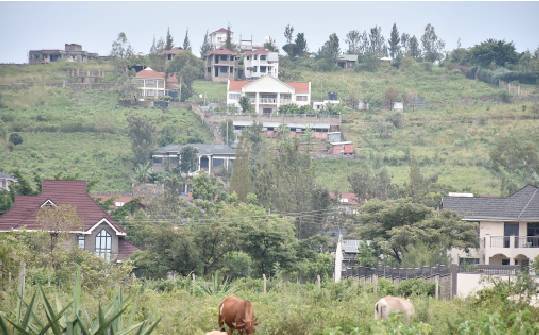‘Scenic views’ pursuit destroys vital habitat on Kisumu hills

Environmentalists and climate change experts are up in arms over what they term as indiscriminate destruction of the environment as developers put up buildings on the hillsides of the lakeside city.
The hills surrounding the lakeside city of Kisumu are witnessing a surge in developments as several investors move to set up palatial homes and businesses.
From a distance, towering palatial homes are taking over the skyline of Kajulu, Riat and Nyahera hills as wealthy businessmen and politicians transform the lakeside city’s outlying areas into a residential paradise, thanks to land shortage in the once-famous neighbourhoods.
Steep and rocky hills that stood in the horizons of Kisumu are now turning into leafy-suburbs as investors’ appetite hits fever pitch and land prices skyrocket.
As such, developers have turned to hill land. The hills and their environs are already being developed and many hillside projects are in the pipe line.
The scramble for the lucrative land, however, is coming at a heavier cost to the environment calling for the attention of environmentalists who believe the developments could become a nightmare in the quest to reverse climate change.
In the wake of the developments, large swathes of vegetation and indigenous trees that have carpeted the hills for decades are being cleared to pave way for construction.
Some of the indigenous trees that once canopied Riat and Kajulu hills are no longer invisible as the environment is ignored in favour of infrastructural investments.
The situation has even seen new informal roads opened further on to the hills to facilitate exploitation of land that had been lying idle for several years.
Environmentalists claim that if the ongoing intrusion is not monitored, the rich hills could soon turn into bare land and worsen soil erosion and silting of Lake Victoria.
Norbert Nyandire, a climate change expert says encroachment on hillside land will lead to many environmental problems, such as deforestation, decimation of water catchments, destruction of endangered fauna and flora, soil erosion, landslides, water pollution, sedimentation and downstream flooding.
“Eventually, there will be cases of increased siltation due to the cutting down of trees and vegetation to pave way for development.
The soil will then be deposited in the lake and as a result encourage the growth of hydrophytes, which might deprive oxygen to fish and other water species in the lake,” he said.
A spot-check by Boma in the affected areas established that the scramble to set up homes and business premises is far from over.
At a parcel of land in a dense forest in Kajulu, a group of men were busy cutting down trees under the supervision of a businessman intending to put up a palatial home. A few metres from the site, a pile of bricks was also being unloaded.
“I was attracted to this area because it offers a serene envirment and scenic views, which would be perfect when I retire,” said the 50-year-old, who declined to be named.
Despite Kajulu hills being one of the sources of water that serves several rivers that empty their waters into Lake Victoria, little has been done to protect it from greedy investors.
Josephat Ouko, a resident claims that the scramble for parcels around the area is informed by the aesthetic beauty and impressive views of the lake and the city that the place offers.
“It is true people are cutting trees to build homes. The city is growing and there is a huge demand for land,” he says.
Attracting high rates
He admits that part of their family land, which had several indigenous trees is among plots that have been cleared to pave way for the construction of homes after they sold it to an investor.
In Mamboleo, huge residential homes have taken over the places where several indigenous trees once stood, threatening the environment.
Lucy Achieng, a real estate agent says demand for land in the affected areas has been high. “The land owners here are selling their land fast because of the large amounts of money their land is fetching,” she says.
She explains that the surge in demand for land in the hillside areas is due to the ever-shrinking land for residential and commercial developments in a city sandwiched between Lake Victoria, an expansive airport and Kano plains, which is synonymous with flooding.
Benard Omondi, the Managing Director West Kenya Real Estate Limited says they sell a one-acre piece of land at between Sh5 million and Sh7 million with their target customers being first-time buyers.
He agrees that there is need to have guidelines for those planning to construct up the hills. However, he claims that developers usually plant new trees after putting up buildings.
“I don’t see anything bad with cutting down trees to pave way for development if the developers are willing to plant new trees around their buildings,” he says.
“Michael Nyanguti, an environmentalist admitted that it may not be easy to stop the degradation, but restrictions should be put in place since the hill tops have always contributed to rainfall, which was predictable, but now rains have become unpredictable.
He told Boma that development is good, but it would be ideal if the investors do environmental impact assessment and engage Nema and other environmental experts before cutting down trees.
During the assessment, he said they should be guided on what needs to be done particularly on mitigation methods and how construction affects the environment.
He added that Nema should come in to ensure that they are doing the right thing and even after construction should ensure that the bare earth is covered.
Tom Togo, the Kisumu county director of environment for Nema said they have been implementing environmental protection laws to ensure that the hills are protected.
He claimed that they have 19 active cases of people who have violated environmental laws while undertaking their developments in the affected areas.
Before the developments moved there, he said there were local indigenous vegetation varied in nature, but now there is going to be a significant loss of trees that are going to be replaced by exotic.
The cutting down of trees he said was a loss to the environment, however, he admitted that looking at the nature of developments taking place, it may not be a total loss as the private developers are likely to plant more.
“As Nema, we can only mitigate any negative impact associated with the development to protect the hills overlooking Kisumu County,” he said.
“Land on Riat Hills belong to individual owners and the government cannot come in and stop them from building, but as Nema, while we may not be against the structures coming up, we have to ensure that before one starts the project, all the potential negative impacts are identified and mitigated.”
Hilly areas, especially those close to towns, not only in Kenya, but in the world have been reported to experience high urbanisation due to high population growth and increase in tourist activity, as a result, they are developed much more than their carrying capacities.
The way forward
Due to high urbanisation, hill towns are facing problems, such as, overcrowding, congestion, chaos, traffic, acute shortage of housing and infrastructure, encroachments, environmental degradation in the form of air, water and noise pollution, disturbance to surface and ground water sources, loss of vegetation, frequent and proneness to heavy damages during natural hazards, absence or poor quality of public spaces and loss of heritage, which results in poor living conditions and deterioration of the environment quality.
The environment and real estate players agree that to mitigate these ill impacts of development, various building regulations along with development plans and proposals, should be enforced.
“To protect the environment in such areas, various environmental regulations related to cutting of slopes, tree preservation, drainage pattern, protection against landslides and earthquakes, rain water harvesting, preservation of natural features and elements and top soil protection and erosion control are enforced,” says Michael in conclusion.












